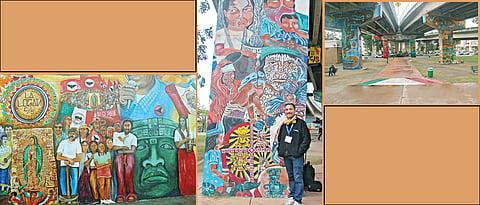

San Diego hardly stands a chance to be on the itinerary of a US tourist, against the more glamorous and popular tourist locales. And to travel to the backyard of this scenic place on the Mexican border, to visit the Chicano Park, would be a far cry. Fortunately, as part of my Fulbright visit, I did just that and came away stunned by the history and the struggles that the locals fought to reclaim their land, which today is listed on the UNESCO heritage sites.
As I descended the overhead bridge, with cars zooming past the urban landscape, the site of the park took my breath away. Each pillar that upheld the highway above was carved with murals and elaborate paintings that spoke volumes of the history and the plight of the indigenous Chicano community.
In the early 20th century, the Logan heights neighbourhood reached all the way to the San Diego Bay and the beach. With the beginning of World War 2, Naval/Defence installations blocked local access to the beach. By the 1950s, the city rezoned the area as mixed residential and industrial one, transforming the community into an industrial junkyard, displacing hundreds of families, and leaving hundreds more with toxic dumpsites from junk dealers and repair shops and air pollution.
To add to the woes of the locals, the Logan Heights was sliced into two by the construction of interstate 5 in 1963 and then further denigrated in 1969 by the construction of the San Diego-Coronado Bridge which further reduced jobs, social or medical facilities.
The park was the only piece of land that truly belonged to the community. There were attempts to build a parking area in that space, which was vehemently opposed by the community. They put up a fight and regained their land. A Chicano Park Steering Committee (CPSC) was formed, which oversaw the restoration and preservation of the park. Today it may look cosy and comfortable, but it has gone through some major struggles.
At that time, local artists were invited to create murals in the park and paint the walls. So today, Chicano Park is home to the world’s largest collection of outdoor murals. The more than 90 murals painted on the bridge’s flyover, columns, ramps and retaining walls transform the bridge’s massive concrete into a towering canvas of expression. These monumental murals depict social, political and cultural issues that form the basis of the liberation of Chicanos/ Mexicans. Along with a handful of sculptures, the murals bring life to this community space with their vibrant imagery. All of them are copyrighted.
Urban Corps Youth, an organisation of the youth of the community, has created a kids playground, tiny-tots area, a handball court, a skate lane, adult outdoor fitness area as well as a central fountain in the park.
There is also a central canopied space that caters to dance performances, workshops, children’s art classes and so on. It is carved with frescos that tell the history of the park. Since 1980, the park has been listed on the Historical Landmarks registry and designated as a National historical landmark.
A strong backbone lending support to this struggle is the Via International, an organisation that works with local grassroot organisations and individuals to address issues and implement programming as per the needs of the communities. Through its volunteering initiative, it strives to integrate community activities with education and cultivate leadership and self-reliance among underserved communities. There are health facilities, schools, counselling centres, job security etc.
The spirit of community involvement that led to the creation of the park is still intact. The park is a living history that has and will continue to survive and thrive.
There is no end to the story of Chicano Park.
